PCP Bioremediation at Eastern Virginia DoD Wood Dip Tank Site
Site Summary
This site is the location of a former Department of Defense dip tank with associated storage racks that has been used to treat wood with a mixture of pentochlorophenol (PCP), diesel fuel and kerosene. The dip tank was dismantled in 1982 and the area was paved with asphalt and converted to a storage area. Subsequent soil and groundwater sampling indicated that PCP was present in both media, with soil concentrations greater than USEPA Region III Risk-Based Contaminant Levels and groundwater concentrations greater than USEPA Maximum Contaminant Levels (MCLs). In 1999, a soil excavation took place at the site removing all the soil above the water table with a PCP concentration greater than 16 mg/kg and the removal of one to three feet of soil below the water table. In 2000, a treatability study was conducted to evaluate the in-situ aerobic bioremediation) of PCP in the groundwater using Oxygen Release Compound (ORC®).
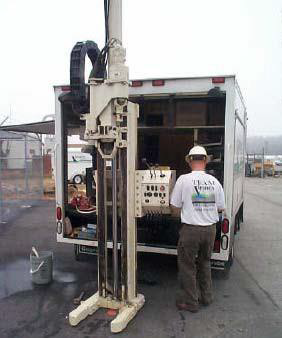
Remediation Approach
- Remediation Objective: Determine the efficacy of using ORC for the reduction of PCP concentrations in groundwater.
- Application Type: Grid (direct-push injection)
- Product: ORC
- Quantity Applied: 1,400 lbs
- Application Rate:
- Upper Aquifer: 6.3 lb/ft
- Lower Aquifer: 3.0 lb/ft
- Product Cost: $14,000
Site Characteristics
General
- Name: DOD Wood Dip Tank Site
- Location: Eastern, VA
- Industry: Wood Treatment
- Contaminants of Concern:
Hydrogeology
- Treatment Area: 5,000 ft2
- Soil Type: Fine to medium sands
- Groundwater Velocity: 0.3 ft/day
- Groundwater Flow Direction: Southwest
- Depth to Groundwater: 5.3 ft

Results
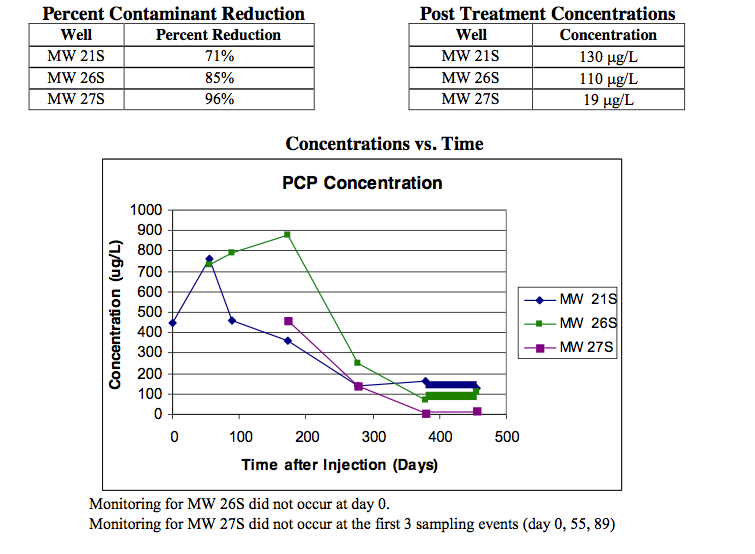
Conclusion
The treatability study performed at the site validated the prediction that ORC-facilitated bioremediation could successfully degrade existing PCP concentrations. After 250 days of observation, sampling of the source well, MW-27S, indicated the successful degradation of PCP by 95.9%. Other wells further from the source also responded well to ORC treatment. Data for each well begins at different time periods following the treatment date because some wells were added after treatment occurred, specifically MW-26S and MW27S. Due to the likely remediation that took place before concentrations were monitored, it is hypothesized that initial concentrations and overall contaminant reduction in MW-26S and MW-27S were higher than existing data indicates. Therefore, it is assumed that the ORC treatment could have performed even better than data indicates.
In Situ Chemical Oxidation of Chlorinated Solvents Using Persulfox™ At An Industrial Site
Overview:
Chlorinated compounds were discovered in shallow groundwater at a former industrial site in Attleboro, Massachusetts. With total VOC concentrations as high as 85,000 ug/L in groundwater, a rapid and aggressive remediation approach was required. In Situ chemical oxidation (ISCO) using PersulfOxTM – catalyzed persulfate was selected to treat a portion of the impacted area which was approximately 35’ long x 35’ wide x 15’ deep and primarily comprised of sand. Three prescribed injections of ISCO using PersulfOx were performed over a 7- month period.
- PersulfOx is a persulfate based ISCO reagent that promotes rapid and sustained in situ oxidation of a wide-range of organic contaminants.
- This patented technology utilizes a unique catalytic surface on which oxidants and contaminants react in a process known as “surface mediated oxidation.”
- PersulfOx also contains built-in activation which eliminates complex and potentially hazardous chemical addition required to achieve traditional persulfate activation.
- From a health and safety aspect, the use of PersulfOx alone is safer than traditional activation methods such as heat, chelated metals, hydrogen peroxide or base.
- If warranted, PersulfOx can also be activated through traditional means to achieve site remediation goals.

Figure 1. Injection wells and monitoring wells
A 10% solution of PersulfOx in water was mixed and injected into a 10-foot treatment thickness using 3 injection wells within the vicinity of monitoring wells MW-16D, MW-16S and MW-8 (Fig.1).
Results:
After each PersulfOx application, an anticipated increase and subsequent decrease in VOCs (resulting from subsurface disturbance and contaminant desorption) was observed. After the 3 prescribed applications of PersulfOx, 2 of the treatment zone wells, MW-16D and MW-8, measured significant VOC removal, 81% and 99% respectively. Treatment zone well MW-16S (the most highly impacted—starting at 85,000 ug/L) showed a significant increase in VOCs after the first 2 injections (indicative of the liberation of soil bound mass). After the third application of PersulfOx, VOC concentrations in MW-16S were clearly decreasing (see figures below).

RegenOx Treats #2 Fuel Oil Plume Beneath Residential Home
CASE SUMMARY
Home Heating Oil, New Jersey
A 550-gallon leaking underground storage tank (UST) containing #2 fuel oil was removed from a single family residence in New Jersey (Figure 1). In addition, the surrounding soil was excavated and sampling was performed to determine the extent of the petroleum hydrocarbon plume within soil and groundwater. The plume was delineated at approximately 1,800 ft2 with
concentrations of total petroleum hydrocarbons as high as 40,000 parts per million (ppm) in soil and approximately 40,000 parts per billion (ppb) in groundwater. An estimated 20% of the plume was determined to be located beneath the home itself, eliminating the option for extensive soil excavation. Other remedial strategies such as pump & treat, monitored natural attenuation, and enhanced fluid recovery were ruled out as they did not provide a timely, cost-effective solution.
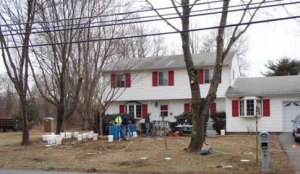
Figure 1. Residential Site
- Soil Type: Fine to Medium Sands
- Treatment Thickness: 5 to 12 feet bgs
- Free Product: 1” to 3” observed
- Contaminants of Concern:
- TPH – Total Petroleum Hydrocarbons
- TVOC – Total Volatile Organic Carbon
- TSVOC – Total Semi-Volatile Organic Carbon
| Contaminant | Concentration |
| TPH – soil | 40,000 ppm |
| TVOC – gw | 7,900 ppb |
| TSVOC – gw | 40,000 ppb |
REMEDIATION TECHNOLOGY
In Situ chemical oxidation (ISCO) using RegenOxTM was chosen as the most appropriate technology to treat the soil and groundwater plume. In addition, an application of a slow-release oxygen compound, ORC Advanced®, was applied following RegenOx to stimulate aerobic biodegradation of any residual contaminants. RegenOx was applied based on the following:
- Least disruptive to the homeowner
- Successful track record
- Feasible site conditions – sandy soils and a shallow water table paired well with direct-push injection
- Low natural organic carbon in saturated zone
- Safe to use and easy to apply
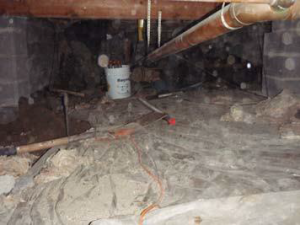
Ten permanent injection points were installed around the source area, at the edge of the plume and beneath the house in the crawl space as seen in Figure 2. During the installation, free phase product was observed in monitoring wells at approximately 1 to 3 inches. The NJDEP’s Permit-by- Rule prohibited the injection of any remediation technology should free product be present. Once the removal was complete, RegenOx could be applied as designed.
CONTAMINANT PLUME TREATMENT
Free Product Removal
The free product was removed using a mild surfactant and a high powered vacuum extraction truck within the source area. This process also effectively distributed the surfactant across the impacted zone for further desorption of contaminants from the soil matrix. Three free product recovery events were performed which effectively removed all free product from the wells and surrounding areas. TVOC concentrations in groundwater dropped only slightly as a result of the free product removal. However, concentrations of TSVOCs more than doubled in groundwater as a result of desorption from soil.
ISCO Injection for TPH Reduction
The application design included two RegenOx injection events and a third combined RegenOx and ORC Advanced injection for on-going biostimulation to treat residual contaminants. Using temporary and permanent injection points, a total of 6,210 pounds of RegenOx was applied from 5 to 11 feet bgs. The third injection included 650 pounds of ORC Advanced.
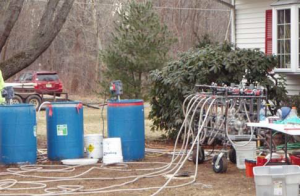

Conclusion
No free product, sheen or film was observed after the injections were completed (Figure 5). Levels of dissolved oxygen 30 days following the final application were measured at approximately 10-20 ppm indicating the presence of ORC Advanced in the subsurface.
Within 6 months, significant reductions in petroleum hydrocarbons were observed. TVOCs declined from 7,900 to <50 ppb and TSVOCs were reduced from 40,000 to <150 ppb. Further Action status from the NJDEP. The site is currently seeking No Further Action status from the NJDEP.
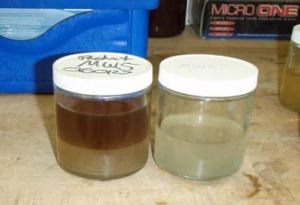
Chlorinated Solvent Concentrations Reduced >100x within Six Months
Enhanced Reductive Dechlorination Used to Treat Former Dry Cleaner in South Carolina Coastal Plain
Project Highlights
- Small groundwater recovery system in place to provide hydraulic control.
- Enhanced Reductive Dechlorination (ERD) treatment selected to achieve site closure more quickly.
- High PCE concentrations reduced by more than 100x within 6 months and remain <5 ug/L two years post-injection.
- Follow-up treatments enhanced initial injection and contributed to continued dechlorination.
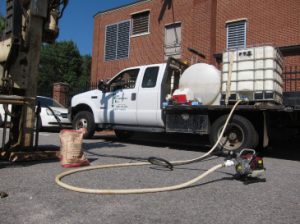
Project Summary
The site, located in the Coastal Plain of South Carolina, was impacted from former dry cleaning operations. A small groundwater recovery system had historically been used to provide hydraulic control, but the site owner wanted to move the site toward closure more quickly. Enhanced Reductive Dechlorination (ERD) with 3-D Microemulsion® was selected based on cost, ease-of-use and expected remediation performance. After the initial injection, PCE concentrations decreased by more than 100x within 6 months of application and remain below 5 ug/L two years after the initial injection.
Remediation Approach
The core of the plume was characterized by concentrations of 14-18 mg/L PCE at baseline plus the full suite of chlorinated ethene daughter products. An initial application of 3-D Microemulsion occurred in June 2011 over a 7,750-square-foot area in the surficial aquifer from 3-25 feet below ground surface. The injections were completed using direct-push equipment into temporary borings on 13-20 foot centers. Based on the success of the initial injection, a follow-up injection was completed in September 2013 over a much smaller footprint (2,200 square feet) to fill in treatment gaps near the upgradient edge of the initial treatment area and to supplement the 3-D Microemulsion in the core of the plume. The follow-up treatment has built on the initial treatment and is contributing to continued depletion of the chlorinated solvents.
Technology Description
3-D Microemulsion is an engineered electron donor material that offers a novel 3-stage electron donor release profile, pH neutral chemistry and is delivered on-site as a factory-emulsified product.
Turn-Key PCE Plume Remediation on at Michigan Superfund Site
Former Manufacturing Facility Treated with 437,000 Pounds of PersulfOx® in 18 Days
Project Highlights
- PersulfOx was selected over other persulfate activation methods because of its inherent health and safety benefits and easy-of-use.
- An aggressive application schedule was implemented to satisfy stakeholders – 37,800 lbs (15,500 gallons) of PersulfOx were injected in a single day.
- On-site diagnostics conducted by RRS confirmed PersulfOx distribution throughout the targeted treatment area.
- The project was completed ahead of schedule and on budget.
- The site was left with minimal impact to the PGA Championship Golf Course.
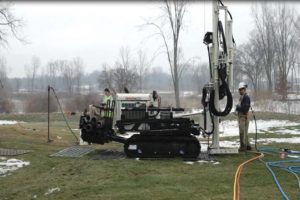
Project Summary
A former manufacturing facility in Western Michigan was redeveloped into an active golf course. The USEPA took over responsibility for cleanup of the chlorinated solvents that remained. Regenesis Remediation Services (RRS) was contracted by a leading consulting fi rm to implement a remediation design to address the chlorinated VOC plume with concentrations as high as 3,000 ppb. PersulfOx was selected over other persulfate activation methods such as hydrogen peroxide or alkaline activate on because the built-in catalyst minimized hazardous materials handling allowing for a safer and easier application. This was especially important because of the treatment areas close proximity to a sensitive receptor (river). Despite persistent freezing temperatures, RRS was able to finish this project ahead of the projected schedule. The RRS team faced a unique challenge on this site as it is a PGA Championship Golf Course which required extreme caution while injecting on the course. Strategic injection point placement, equipment staging, and surface protection via mats were just a few of the techniques implemented by the team
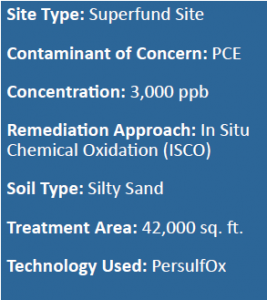
Remediation Approach
The 18-day injection event included 437,000 pounds of PersulfOx which was applied through 129 injection points in a grid pattern 5-30 feet below ground surface. The team used two direct-push injection machines to apply PersulfOx into eight points injection simultaneously.
Technology Description
PersulfOx is a sodium persulfate-based chemical oxidation technology which destroys both hydrocarbon and chlorinated solvent-type contaminants in the subsurface. PersulfOx contains a built-in catalyst which activates the persulfate componentand generates contaminant-destroying free radicals without the need for the addition of a separate activator.
Barrier Design and Angled Injections used to Treat BTEX and MTBE to Non-Detect
Project Highlights
- A former service station was contaminated with BTEX and MTBE.
- Enhanced aerobic biodegradation using ORC Advanced was used for treatment.
- The remediation design utilized a staggered, barrier configuration to optimize oxygen distribution.
- Angled injections were used to deliver ORC Advanced beneath the restaurant.

Summary
A former gasoline service station in Colorado had three petroleum underground storage tanks
(USTs) and associated product dispensers/lines removed in 2009. Subsequent site investigation activities delineated the majority of soil and groundwater contamination, identified LNAPL and groundwater impacts as high as 7.45 mg/L for benzene and 21.9 mg/L for MTBE. A soil vapor extraction well and numerous enhanced fluid recovery (EFR) events were performed between January 2001 and November 2011 to remove LNAPL.
LNAPL levels were removed and injection technologies were evaluated to polish the remaining groundwater plume.Because the site had been converted to a busy restaurant it was imperative the selected technology allow for relatively quick injections and mitigate potential surfacing with would cause unwanted aesthetic and health and safety concerns. After evaluating several other enhanced bioremediation options ORC® Advanced was selected for direct-push injection at the site.
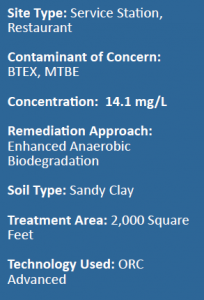
Remediation Approach
A series of enhanced biodegradation treatment barriers were placed along the length of the plume source and staggered to optimize oxygen distribution through the aquifer. Angled injections were required to place 24 points of ORC Advanced in multiple treatment rows beneath the restaurant and drive-through lanes. Since depth to groundwater was roughly 28-feet below ground surface this aided in the ability to angle inject product to all required locations beneath the restaurant property. Approximately 1,200 pounds of ORC Advanced was injected on-site.
Post ORC Advanced application, the monitoring well beneath the restaurant and directly below the former tank excavation has measured below detection limits for four quarters. Another well located just below the former east end of the tank excavation was below detection limits for the previous three quarters starting with the first quarter after injection. Although groundwater treatment in the main plume has proven to be effective, additional LNAPL was since identified at wells farther east of the restaurant and of the former tank excavation. This unexpected discovery of LNAPL post-treatment may undergo additional EFR and potential ORC Advanced application.
Technology Description
Advanced Formula Oxygen Release Compound (ORC Advanced®) is a proprietary formulation of food-grade, calcium oxy-hydroxide that produces a controlled-release of molecular oxygen for periods of up to 12 months upon hydration.

 Americas
Americas Europe
Europe Français
Français Deutsch
Deutsch Italiano
Italiano Español
Español

